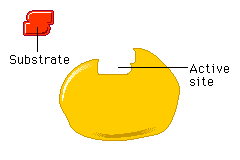top of page
The bioreceptor is essentially the biological component that the target analyte binds to. By interacting with a particular molecule, the bioreceptor undergoes or initiates a change that indicates the transducer that the target analyte has been found. The bioreceptor often has an unique shape that has a strong affinity for one and only one specific molecule, which will draw the molecule in if present in the solution. The bioreceptor will encase the target analyte perfectly with a "key in the lock" fit and when this happens, the bioreceptor will change in a temporary fashion. Bioreceptors can be classified into one of five categories, and can attach to the transducer in one of four ways. Learn about them all below!
~Here are the most common types of bioreceptors and their definitions~
-
Antibodies: These Y-shaped proteins are designed by the immune system to identify and get rid of alien objects in the body. When employed as a bioreceptor, antibodies can detect antigens, which are the foreign objects that inevitably stick to the antibodies' binding site. Since the body makes new antibodies every time a new object enters, one can count on antibodies to be highly specific and bind to the correct analyte/antigen.
-
Enzymes: Enzymes are proteins that catalyze or accelerate chemical reactions by lowering the activation energy required for the reaction to take place. These enzymes make great bioreceptors because they too have selective binding sites that accept only one substrate to stress and manipulate. Enzymes also temporarily change shape while attached to the analyte and cause the subrate to become a product, which can be easily detected by the transducer.
-
Nucleic Acids: DNA and RNA are molecules composed of only four nucleotides but are the genetic makeup of every living thing. The unique sequence of As, Ts, Cs, and Gs not only provide genetic variation, but also act as terrific bioreceptors because each strand of DNA is so different. Oligonucleotides, or short and single stranded DNA or RNA fragments, are used the most to locate these complementary, unique strands.
-
Cellular Parts & Cells: Cells, which are the smallest unit of life can be used as bioreceptors to detect toxicity. Microrganisms such as bacteria, various tissues, and cell organelles are also used because they react to pollution in an apparent manner.
-
Biomimetic: These bioreceptors are man-made and are created by synthetic biology. Biomimetic often implies either genetically engineered molecules for bioreceptors, artificial membranes, or molecular imprinting, which is a technique that ends with polymers having holes or pockets that can detect the target analyte.







~Bioreceptors can bind to the transducer surface in 1 of 4 ways~
SENSOR
SENSOR
SEMIPERMEABLE MEMBRANE
MEMBRANE
In membrane entrapment, a semipermeable membrane separates the bioreceptor from the target analyte. Instead, the bioreceptor is attached to the transducer.
The physical adsorption configuration combines van der Waals, hydrophobic interactions, hydrogen bonds, and ionic forces to bind the bioreceptor with the transducer.
MEMBRANE ENTRAPMENT
PHYSICAL ADSORPTION
POROUS
ENCAPSULATION
SENSOR
The porous encapsulation arrangement deals with forming a permeable envelope around the bioreceptor that anchors it to the transducer.
POROUS ENCAPSULATION
COVALENT
BONDING
SENSOR
COVALENT BONDING
In covalent bonding, the transducer acts like a reactive group to covalently bond with the bioreceptor.

(I-6)
(I-7)
(I-8)
(I-110)
(I-111)
(I-112)
(I-113)
(I-114)
bottom of page